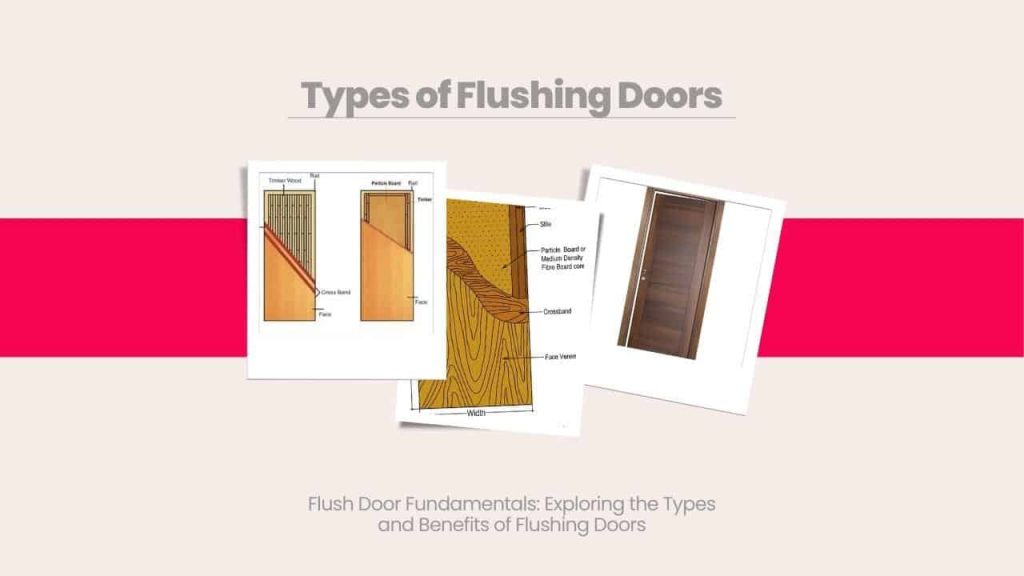Work Hours
Monday to Friday: 7AM - 7PM
Weekend: 10AM - 5PM
Mostly Used Types of Flushing Doors

Flushing doors are a popular choice for both residential and commercial buildings due to their sleek and modern design. They offer several advantages, such as better insulation and noise reduction, and can be used for both interior and exterior purposes. However, it is essential to understand what flushing doors are and the different types available. This article provides a comprehensive overview of flushing doors, defining them and detailing the various types. Whether you are a homeowner looking to update your interior design or a builder seeking the best door options for your project, understanding the types of flushing doors available will help you make an informed decision.
A flushing door is a door that is designed to be flush with the surrounding wall surface when closed. Unlike other types of doors that protrude from the wall when closed, a flushing door sits evenly with the wall’s surface. Flushing doors are commonly used in modern architecture because of their sleek and minimalistic appearance. In addition to their aesthetic appeal, they are also practical in spaces where space is limited. The design of flushing doors has made them a popular choice for architects, builders, and homeowners alike.
Uses of Flushing Doors
- Space-saving: Flushing doors are ideal for limited space, as they do not swing out into the room when opened. This makes them popular for smaller rooms or spaces, such as closets or storage areas.
- Aesthetic Appeal: Flushing doors offer a clean and modern look, which makes them a popular choice for contemporary buildings. They blend seamlessly with the surrounding wall surface, creating a sleek and minimalist appearance.
- Privacy and Soundproofing: Flushing doors provide a high level of privacy and soundproofing, essential in areas such as offices, conference rooms, or bedrooms. They can help reduce noise transfer and ensure confidential conversations are not overheard.
- Safety and Security: Flushing doors can be designed to be fire-resistant, which is essential in commercial and public buildings where safety is a priority. They can also be made more secure using materials such as metal or reinforced glass.
- Natural Light: Flushing doors made from glass can allow natural light to flow into a room, which is beneficial in areas such as offices or public buildings. This can reduce the need for artificial lighting and create a more comfortable and welcoming space.
Also Read: Types of Scaffolding used in Construction
Mostly used types of Flushing Doors
1) Solid Core Flushing Doors
Solid Core Flushing Doors consist of a solid core made from composite materials like medium-density fiberboard (MDF), particleboard, or plywood, providing superior sound insulation and robustness than hollow core doors. The door design is completely flat on both sides, with no raised or recessed panels, providing a contemporary look that suits different interior styles. Solid Core Flushing Doors are heavier than hollow core doors, making them resistant to dents and scratches. They offer better sound insulation, making them ideal for rooms that require noise control and privacy.
2) Hollow Core Flushing Doors
Hollow Core Flushing Doors feature a hollow core that is sandwiched between two thin sheets of veneer or plywood, making them lightweight and affordable, which makes them suitable for commercial and residential purposes. Hollow Core Flushing Doors are less durable than solid-core doors and offer less sound insulation. However, they remain an excellent option for spaces where privacy and noise reduction are not primary concerns.
3) Glass Flushing Doors
Glass Flushing Doors incorporate glass panels into their design, allowing natural light to pass through and make space feel airy. These doors are typically solid-core, and the glass pane can be clear, frosted, or textured. The flat design on both sides without any raised or recessed panels gives these doors a modern and sleek appearance.
4) Metal Flushing Doors
Metal Flushing Doors are constructed using aluminum or steel as their primary material and are commonly used for both interior and exterior purposes. They are durable, strong, and resistant to damage, making them a popular choice for commercial and industrial applications.
5) Louvered Flushing Doors
Louvered Flushing Doors feature adjustable slats, or louvers, in their design, providing ventilation and light while maintaining privacy and reducing noise. They are ideal for use in areas such as closets and laundry rooms that require ventilation. They can also be used as entryways or room dividers and are available in various materials like metal, composite materials, and wood. Louvered Flushing Doors can be customized with different finishes, stains, and paint colors to match the overall decor of the room.
Conclusion
In summary, flushing doors are a popular choice for their sleek and modern design, space-saving properties, aesthetic appeal, privacy and soundproofing features, safety and security benefits, and ability to allow natural light. There are several types of flushing doors available, including solid core, hollow core, glass, metal, and louvered, each with its unique advantages and applications. When choosing a flushing door, it is essential to consider the specific needs of the space, including its size, use, and desired aesthetics.
Try Onsite, #1 Tool For Site Tracking




